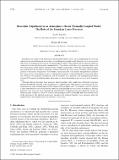Baroclinic Adjustment in an Atmosphere–Ocean Thermally Coupled Model: The Role of the Boundary Layer Processes
Author(s)
Zhang, Yang; Stone, Peter H.
DownloadZhang-2011-Baroclinic Adjustmen.pdf (1.787Mb)
PUBLISHER_POLICY
Publisher Policy
Article is made available in accordance with the publisher's policy and may be subject to US copyright law. Please refer to the publisher's site for terms of use.
Terms of use
Metadata
Show full item recordAbstract
Baroclinic eddy equilibration and the roles of different boundary layer processes in limiting the baroclinic adjustment are studied using an atmosphere–ocean thermally coupled model. Boundary layer processes not only affect the dynamical constraint of the midlatitude baroclinic eddy equilibration but also are important components in the underlying surface energy budget. The authors' study shows that baroclinic eddies, with the strong mixing of the surface air temperature, compete against the fast boundary layer thermal damping and enhance the meridional variation of surface sensible heat flux, acting to reduce the meridional gradient of the surface temperature. Nevertheless, the requirement of the surface energy balance indicates that strong surface baroclinicity is always maintained in response to the meridionally varying solar radiation. With the strong surface baroclinicity and the boundary layer processes, the homogenized potential vorticity (PV) suggested in the baroclinic adjustment are never observed near the surface or in the boundary layer.
Although different boundary layer processes affect baroclinic eddy equilibration differently with more dynamical feedbacks and time scales included in the coupled system, their influence in limiting the PV homogenization is more uniform compared with the previous uncoupled runs. The boundary layer PV structure is more determined by the strength of the boundary layer damping than the surface baroclinicity. Stronger boundary layer processes always prevent the lower-level PV homogenization more efficiently. Above the boundary layer, a relatively robust PV structure with homogenized PV around 600–800 hPa is obtained in all of the simulations. The detailed mechanisms through which different boundary layer processes affect the equilibration of the coupled system are discussed in this study.
Date issued
2011-11Department
Massachusetts Institute of Technology. Department of Earth, Atmospheric, and Planetary SciencesJournal
Journal of the Atmospheric Sciences
Publisher
American Meteorological Society
Citation
Zhang, Yang, and Peter H. Stone. “Baroclinic Adjustment in an Atmosphere–Ocean Thermally Coupled Model: The Role of the Boundary Layer Processes.” Journal of the Atmospheric Sciences 68.11 (2011): 2710–2730. © 2011 American Meteorological Society
Version: Final published version
ISSN
0022-4928
1520-0469